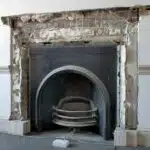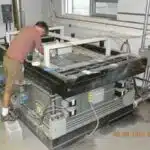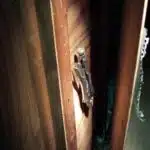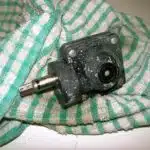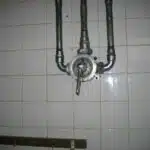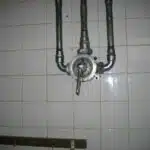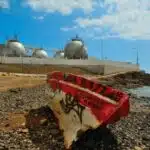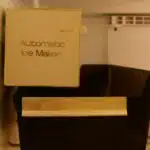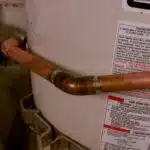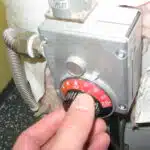As a gas fireplace technician or installer, it is important to educate homeowners on the proper use and maintenance of their gas fireplaces. One common question that arises is how to turn on a gas fireplace with a wall key. While some may find the process intimidating, it is actually quite simple once you understand the steps involved.
In this article, we will provide a step-by-step guide on how to turn on a gas fireplace with a wall key. We will cover everything from preparing the fireplace for use, locating and using the wall key, and troubleshooting common issues that may arise during the process. Whether you are a homeowner looking to learn more about your gas fireplace or a technician seeking to educate your clients, this article will serve as a valuable resource for all those interested in safely and effectively operating their gas fireplaces.
Preparing Your Gas Fireplace For Use
Gas fireplace safety is of the utmost importance when it comes to preparing your gas fireplace for use. Before turning on the gas, be sure to examine your fireplace’s outer surface for any cracks, chips, or other signs of wear and tear. Additionally, make sure that there are no loose parts inside the fireplace. This can be done by gently shaking the unit and listening for any rattling noises.
Cleaning tips are also important when it comes to maintaining your gas fireplace’s functionality. The inside of the unit should be cleaned regularly to ensure that there is no buildup of dirt or debris. This can lead to clogs in the gas line and other issues with the functionality of the fireplace. Additionally, make sure that any dust or debris is cleared away from the outside vents in order to maintain proper ventilation.
Understanding how to properly operate a wall key is crucial when using a gas fireplace. These keys are typically located near the unit itself and allow for easy control of both the flame height and heat output. It is important to read all instructions carefully before attempting to turn on your gas fireplace using a wall key. By following these instructions and taking necessary precautions, you can safely enjoy a warm fire in your home without worry.
Understanding The Wall Key
- Wall keys are specialized tools used to start, turn off, and adjust the flame of a gas fireplace.
- There are several different types of wall keys, each designed to fit in a corresponding valve stem.
- In order to use a wall key, it is important to identify the type and size of key that is compatible with the gas fireplace’s valve stem.
- The wall key should be inserted into the valve stem and turned to the desired position to start, adjust, or turn off the flame of the gas fireplace.
- It is also important to understand the controls associated with the wall key, such as the knob or knob-and-button combination to adjust the flame size.
- Gas fireplace technicians and installers should have a thorough understanding of wall keys and their associated controls in order to properly install and maintain gas fireplaces.
Types Of Wall Keys
Understanding the wall key is essential for anyone who owns a gas fireplace. It is the device that controls the flow of gas into the fireplace, allowing it to ignite and produce heat. One of the most common types of wall keys is the manual key. This type of key is simple to use and requires no electricity or batteries, making it a reliable option for homeowners. Another type of wall key is the electronic key, which uses electricity to turn on and off the gas flow. This type of key might require more maintenance than manual keys but offers convenience and precision in controlling your fireplace’s temperature.
When it comes to choosing between a wall key and a remote control for your gas fireplace, there are several benefits to using a wall key. For starters, wall keys are less likely to malfunction since they do not rely on batteries or electricity. They also offer more precise control over your fireplace’s temperature, allowing you to make adjustments easily as needed. Additionally, since they are fixed onto the wall, you can ensure that they will always be within reach when you need them.
There are many types of wall keys available in today’s market, each with its unique features and advantages. Understanding these options can help you choose the best one for your needs. Overall, using a wall key instead of a remote control provides greater reliability and precision in controlling your gas fireplace’s temperature – an essential factor in ensuring comfort and safety in your home during cold weather conditions.
Identifying The Wall Key
Understanding the wall key is crucial for anyone who owns a gas fireplace, and identifying the key features of this device is equally important. Identifying the wall key means being able to differentiate between the different types of wall keys available on the market. While manual and electronic keys are common types of wall keys, there are also other options worth considering.
One type of wall key that homeowners can use is the decorative key. This type of key adds an aesthetic touch to your fireplace while still providing you with reliable control over its temperature. Another option is a universal key, which works with any gas valve and can be used as a replacement for lost or damaged keys. It is essential to identify these different types of wall keys to ensure that you choose one that meets your needs.
Whether you opt for a manual or electronic key, it’s critical to identify their unique features before making your choice. Manual keys provide simple control without any electrical components, while electronic keys offer precision and convenience in controlling your fireplace’s temperature. By identifying these differences and choosing the right type of wall key for your gas fireplace, you can ensure comfort and safety during cold weather conditions.
Understanding The Controls
Understanding the controls of a gas fireplace is essential to ensure its proper functioning and safety. The wall key, as discussed in the previous subtopic, is one of the essential components that help control the temperature of a gas fireplace. However, it is not the only control mechanism available. Gas fireplaces have various other controls that homeowners should be aware of to ensure their safety and proper maintenance.
One such control mechanism is the pilot light, which provides a small flame that ignites the gas when needed. This feature ensures that there is always a small flame burning on your gas fireplace and helps prevent dangerous gas buildup. Additionally, some gas fireplaces have thermostats that allow you to set a specific temperature for your room. Once the desired temperature is reached, this control mechanism will turn off the burner until heat levels drop below the set temperature.
Gas fireplace safety and maintenance are critical aspects that homeowners should prioritize. To ensure proper maintenance and safety measures, it’s necessary to understand all the different control mechanisms available on your gas fireplace thoroughly. Regular cleaning and inspection can help detect any potential issues before they become hazardous or costly problems for homeowners. Proper use of these controls can also help save energy costs and prolong the lifespan of your gas fireplace system.
In conclusion, understanding the controls available on your gas fireplace can significantly impact its performance, safety, and longevity. With regular maintenance checks and careful use of these controls mechanisms like pilot lights or thermostats, homeowners can keep their families safe while enjoying a warm home during cold weather conditions. It’s essential to keep these points in mind while operating your gas fireplace system to make sure it remains efficient and safe at all times.
Finding The Wall Key
Understanding the Wall Key is important when operating a gas fireplace. It serves as the primary tool to control the flow of gas into the unit, regulating the intensity of heat and flame. However, before one can turn on their gas fireplace using a wall key, they must first locate it.
Locating key storage is essential in finding the wall key. The majority of gas fireplaces come with a wall switch or remote control that allows for easy operation from a distance. However, if these options are not available or malfunctioning, homeowners must find the physical wall key. Wall keys are typically located near the fireplace unit itself or in close proximity to it. They can be mounted on a nearby wall or stored in a designated compartment within the unit.
Identifying compatible wall keys is also crucial in ensuring proper use and safety. Different gas fireplaces require different types of keys to function correctly. A universal key may work with most models, but it is best to refer to the owner’s manual or consult with a professional technician to determine which type of key is compatible with your specific unit.
With an understanding of where to locate and which key to use, turning on your gas fireplace becomes an effortless task. However, it is equally important to know how to turn off your fireplace safely when not in use. In the next section, we will discuss how to properly shut off the gas supply and ensure that your unit remains secure until its next use.
Turning Off The Gas Supply
As a gas fireplace technician, it is essential to ensure that the gas supply is turned off properly after use. According to statistics, 20% of gas fireplace accidents are caused by leaving the gas supply on. Therefore, it is necessary to take safety precautions when turning off the gas supply.
To check the gas pressure, you must first locate the shut-off valve and turn it clockwise until it stops. Once this has been done, you should wait for a few minutes before checking the gas pressure to ensure that there is no residual gas in the system. It is also important to inspect all connections and fittings for any signs of wear or damage and replace them if necessary.
To further ensure safety, always make sure that flammable materials such as paper, wood, or furniture are at a safe distance from your fireplace. Never leave your fireplace unattended while it’s still burning. Finally, be sure to have a professional technician perform regular maintenance checks on your fireplace to prevent accidents and malfunctions from occurring.
Now that we’ve discussed how to turn off the gas supply safely let’s move onto inserting the wall key.
Inserting The Wall Key
Once you have verified that your gas fireplace is compatible with a wall key, you can proceed to insert it into the designated slot. The wall key acts as a switch that controls the flow of gas into the fireplace. It is usually located near the fireplace or in a nearby utility closet.
It is important to note that not all gas fireplaces are compatible with a wall key. Some models require alternative methods for turning on the fireplace, such as remote control or manual switches located on the unit itself. Therefore, before attempting to use a wall key, be sure to check your owner’s manual or consult with a professional installer to ensure compatibility.
To insert the wall key, simply align it with the slot and push it in firmly until it clicks into place. Once inserted, turn the key clockwise to open the gas valve and allow gas to flow into the unit. It’s important to remember that only trained professionals should handle any repairs or maintenance involving gas lines and equipment.
Table:
| Wall Key Compatibility | Wall Key Alternatives |
|---|---|
| Most traditional gas fireplaces | Remote Control |
| Gas logs | Manual Switches |
| Vent-free fireplaces |
In preparation for turning on your gas fireplace using a wall key, verify its compatibility with your unit and locate where it needs to be inserted. Remember that there are alternative methods available if your unit is not compatible with a wall key. By following proper safety guidelines and manufacturer instructions, you can enjoy warmth and ambiance from your gas fireplace for years to come. In the next section, we will discuss how to turn on the gas valve once you have inserted the wall key correctly.
Turning On The Gas Valve
- The first step in turning on the gas valve of a gas fireplace is locating the gas valve.
- The gas valve is typically located behind the gas fireplace control panel, so the control panel must be removed to access it.
- After locating the gas valve, turn the gas valve in a clockwise direction to open the valve.
- Open the gas valve slowly, to ensure the valve does not open too quickly and cause a gas leak.
- After turning the gas valve on, test for leaks using a gas leak detector.
- If a leak is detected, turn off the gas valve and contact a certified gas fireplace technician for further assistance.
Locating The Gas Valve
Locating the Gas Valve is crucial when turning on a gas fireplace with a wall key. For those who are new to gas fireplaces, it is important to know that the gas valve controls the flow of gas to the fireplace. It is usually located near the fireplace and can be accessed by removing the front panel or a metal plate. However, it is essential to take safety precautions before accessing the gas valve.
Gas Valve location tips include checking inside and outside the fireplace area for a lever or knob that controls the gas supply. The valve may also be located near the floor next to the fireplace or inside a nearby wall. If you are unable to locate it, refer to your manufacturer’s manual or call a professional technician for assistance. When accessing the valve, make sure there are no flammable materials nearby, and turn off all electrical appliances in the room.
Safety precautions when accessing Gas Valve include wearing protective gloves and goggles. Ensure adequate ventilation in the room by opening doors and windows before accessing the valve. Keep an approved fire extinguisher nearby in case of emergencies and never use matches or lighters to test for leaks. Instead, use non-abrasive soap solution or specialized leak detection equipment.
In conclusion, Locating Gas Valve is an essential step when turning on your gas fireplace with a wall key. Always take safety precautions before accessing it as gas leakage can lead to hazardous situations such as explosions or fires. By following these tips and guidelines, you can safely enjoy your cozy fire during winter months without any worries about safety risks associated with using your gas fireplace with ease!
Turning The Gas Valve On
After locating the gas valve, the next step in turning on a gas fireplace with a wall key is to turn the gas valve on. Before doing so, it’s important to check the gas pressure and ensure that the proper maintenance has been performed on the gas valve. Checking the gas pressure is crucial to ensure that there is enough pressure for the fireplace to operate safely and efficiently.
To turn on the gas valve, first locate the control knob or lever. The knob or lever should be labeled “on” or have an arrow pointing in that direction. Turn the knob or lever to the “on” position and listen for a hissing sound – this indicates that gas is flowing into the fireplace. If you don’t hear any hissing, double-check that you have turned the knob or lever all the way to “on”.
Proper maintenance of your gas valve is essential for safe and efficient operation of your gas fireplace. Regularly inspecting and cleaning your gas valve can help prevent leaks and other safety issues from occurring. It’s important to follow manufacturer guidelines for maintenance and consult a professional technician if you are unsure about any aspect of maintaining your gas valve. By taking these steps, you can enjoy a cozy fire without worrying about safety risks associated with using your gas fireplace with ease!
Testing The Gas Valve
After turning on the gas valve, it’s crucial to test the gas valve to ensure that there are no leaks or other issues. The first step in testing the gas valve is to check the gas pressure. This can be done using a manometer, which measures the pressure of gas flowing through the valve. If the pressure is too high or too low, adjustments may need to be made to ensure safe and efficient operation.
Another important aspect of testing the gas valve is checking for any loose or faulty connections. Gas leaks can be dangerous and even deadly, so it’s essential to make sure that all connections are secure and in good condition. A professional technician can perform a thorough inspection of your gas valve and make any necessary repairs or replacements.
Overall, testing the gas valve is an important step in ensuring the safety and efficiency of your gas fireplace. By regularly inspecting and maintaining your gas valve, you can enjoy a cozy fire without worrying about any potential risks associated with using your fireplace. Remember to always follow manufacturer guidelines for maintenance and consult a professional technician if you have any concerns about your gas fireplace or its components.
Lighting The Pilot Light
As we have learned in the previous section, turning on the gas valve is the first step towards igniting a gas fireplace with a wall key. However, before proceeding with lighting the pilot light, it is crucial to check the gas pressure. This will ensure that your gas fireplace is receiving an adequate amount of fuel for proper ignition.
Checking gas pressure requires specialized equipment and should only be done by a licensed technician. Ignoring this step could lead to ignition problems, such as weak flames or no flames at all. If you suspect any issues with your gas pressure, it is best to call a professional immediately.
Once you have confirmed that your gas pressure is stable, proceed to lighting the pilot light. However, if you encounter ignition problems despite following all the steps correctly, do not attempt to troubleshoot yourself. It could be due to many factors such as faulty thermocouple or clogged burners. In such cases, contact a qualified technician who can diagnose and fix any issues promptly.
Adjusting the flame is essential for maintaining optimal heat output and energy efficiency of your gas fireplace. Let us now move on to the next section and learn how to adjust the flame properly for your comfort and safety.
Adjusting The Flame
- The flame level of a gas fireplace is determined by the amount of gas passing through the burner.
- Adjusting the flame height is done by turning the wall key which controls the flow of the gas to the fireplace.
- Turning the wall key clockwise will increase the flame whereas turning it counterclockwise will reduce the flame.
- The wall key should be turned slowly and carefully to ensure the desired flame level is achieved.
Setting The Flame Level
Adjusting the flame height on a gas fireplace is an important step in creating the perfect ambiance for your living space. It can be done using the wall key that controls the gas valve. To adjust the flame level, you need to turn the wall key clockwise to increase and counterclockwise to decrease the flame height. The key should be turned slowly and gently to avoid sudden changes in flame intensity.
Before adjusting the flame height, it is crucial to take some safety precautions. First, make sure that there are no flammable materials around the fireplace, such as curtains or rugs. Second, check if all components of your gas fireplace are functioning correctly, including its venting system and thermocouple. Third, always have a fire extinguisher nearby in case of any emergencies.
When adjusting the flame height, keep in mind that a higher flame level means more heat output, which can be dangerous if not managed properly. Set a comfortable temperature for your room and monitor it closely while making any adjustments to prevent overheating or possible carbon monoxide poisoning. Additionally, never leave your gas fireplace unattended while it’s on and always turn off the gas valve when not in use.
In summary, adjusting the flame height is an essential part of maintaining an efficient and safe gas fireplace operation. Remember to follow safety precautions at all times and keep an eye on temperature levels while making any adjustments to achieve optimal comfort and relaxation for your home.
Adjusting The Flame Height
Flame height customization is a crucial aspect of gas fireplace operation that allows homeowners to adjust the intensity of the flames according to their preferences. To achieve optimal comfort and ambiance, it is important to follow safety measures while adjusting the flame height. Before making any adjustments, ensure that there are no flammable materials around the fireplace, check if all components are functioning correctly, and have a fire extinguisher nearby in case of an emergency.
When adjusting the flame height, it is essential to be mindful of the heat output level. A higher flame level means more heat output, which can be dangerous if not managed properly. Therefore, it is crucial to set a comfortable temperature for your room and monitor it closely while making any adjustments to prevent overheating or possible carbon monoxide poisoning. Additionally, never leave your gas fireplace unattended while it’s on and always turn off the gas valve when not in use.
In summary, flame height customization plays an integral role in achieving optimal comfort and relaxation for your home. By following safety measures such as checking all components of your gas fireplace before making any adjustments and monitoring temperature levels closely during the process, you can ensure safe and efficient operation of your gas fireplace for years to come.
Turning Off The Gas Fireplace With A Wall Key
Turning off the Gas Fireplace with a Wall Key is just as important as turning it on. After enjoying the warmth and ambiance of your gas fireplace, you must ensure that it is turned off properly for safety reasons. It is important to note that every manufacturer may have different instructions for using their wall key. Therefore, it is essential to read the manual before operating your gas fireplace.
To turn off the gas fireplace with a wall key, follow these simple steps:
- Locate the wall key – The wall key is usually located near the gas valve or control panel.
- Insert the key – Insert the key into the valve and turn it counterclockwise until you hear a hissing sound indicating that the gas is turned off.
- Store the key – Remove and store the wall key in a safe place.
Wall Key Safety should be taken seriously as improper use can lead to serious accidents such as fire or gas leaks. Always make sure that your wall key is kept out of reach of children and pets. Additionally, never force or use excessive pressure when inserting or turning your wall key as this can cause damage to both the valve and key.
In conclusion, knowing how to turn off your gas fireplace with a wall key is just as important as knowing how to turn it on. Proper usage of your wall key ensures not only safety but also longevity of your appliance. However, if you do experience any issues while using your gas fireplace, refer to our next section on Troubleshooting Common Issues for assistance.
Troubleshooting Common Issues
As a gas fireplace technician or installer, it is essential to understand that the process of turning on a gas fireplace with a wall key is simple. However, sometimes issues may arise while starting the fireplace, even with the right installation and correct usage. As a technician, it is your responsibility to identify and solve any problems that might occur during this process.
Imagine you are in a cold winter night, looking forward to sitting by your warm gas fireplace. However, when you turn your wall key to switch on the fireplace, nothing happens. This situation can be frustrating for homeowners who rely on their gas fireplaces as their primary source of heat. Some of the common issues faced by gas fireplace owners include clogged burners and valves or malfunctioning pilot lights.
To troubleshoot these common pilot light issues and clogged burners, you need to ensure that the gas is flowing correctly from the main supply line. Additionally, check for any blockages or debris in the burner holes or valve. A technician should also check if there is proper ventilation since insufficient air supply leads to low flames and weak heat output. Lastly, ensure that all connections are tight and secure before turning on your gas fireplace with a wall key.
Next up in troubleshooting common issues associated with operating a gas fireplace with a wall key is checking for gas leaks. It’s crucial to inspect every connection point – from the main supply line to every part of your gas furnace – for potential leaks. This inspection helps prevent accidents caused by natural gas leaks such as fires or explosions leading to property damage or injury.
Checking For Gas Leaks
Before turning on your gas fireplace with a wall key, it is important to check for gas leaks. Gas leaks can be very dangerous and even deadly if not detected early. Therefore, it is essential to take safety precautions before using the fireplace.
To check for gas leaks, use a mixture of soap and water to create a solution. Apply this solution around the connections and valves of the gas line leading to the fireplace. If there is a leak, bubbles will appear in the solution, indicating that gas is escaping. In case you detect any leakage, do not attempt to use the fireplace until you have had it checked by a professional technician.
Safety precautions are paramount when dealing with gas fireplaces. It is recommended that you have your gas fireplace inspected annually by a licensed technician who can identify any potential problems or issues and fix them promptly. Moreover, ensure that all flammable materials are kept at least three feet away from the fireplace while in use. Always turn off the gas supply valve when not using the fireplace and never leave it unattended while in operation. By taking these precautions seriously, you can enjoy your cozy and warm fireplace safely for years to come.
Moving forward, maintaining your gas fireplace is crucial as it ensures its proper functioning and enhances its longevity. Therefore, after ensuring safety measures are adhered to before starting up your gas fireplace through a wall key, follow these maintenance guidelines closely to guarantee its optimal performance throughout its lifespan.
Maintaining Your Gas Fireplace
As a gas fireplace technician, it is important to emphasize the significance of gas fireplace maintenance. A gas fireplace is an excellent source of warmth and comfort in a home, but it also requires attention to ensure its safe operation. There are several safety precautions that homeowners must be aware of when using their gas fireplaces.
Firstly, it is essential to have a professional inspect and clean your gas fireplace annually. This will help identify any potential issues that may pose a threat to your safety. Additionally, it is crucial to avoid using any flammable liquids or materials near your gas fireplace. Doing so can cause a fire or explosion, which can lead to significant damage or injury.
Lastly, make sure to check the batteries in your carbon monoxide detector regularly and replace them when needed. Carbon monoxide poisoning can occur if there is an issue with your gas fireplace’s ventilation system. Regularly checking your detector can help prevent this from happening and keep you and your loved ones safe.
Gas fireplace maintenance and safety precautions should never be taken lightly. By following these simple steps, you can ensure the safe operation of your gas fireplace for years to come. In the next section, we’ll discuss how to clean your gas fireplace properly and efficiently to keep it functioning at its best.
Cleaning Your Gas Fireplace
Keeping your gas fireplace in good working condition requires regular cleaning. This not only helps to maintain its appearance, but also ensures that it operates safely and efficiently. Cleaning tools such as a soft-bristled brush, vacuum cleaner, and glass cleaner are essential for cleaning different parts of the fireplace.
The frequency of cleaning your gas fireplace depends on how often you use it. For instance, if you use it every day during winter, you may need to clean it at least once a month. On the other hand, if you only use it occasionally or during special occasions, then once or twice a year may be sufficient. It’s important to note that neglecting to clean your gas fireplace can lead to the accumulation of dust and debris that can clog the burners and cause the pilot light to go out.
When cleaning your gas fireplace, start by turning off the gas supply and letting it cool down completely before removing any debris from inside the unit. Use a soft-bristled brush or vacuum cleaner to remove loose dust and debris from the firebox and logs. Next, clean the glass doors with a glass cleaner using a lint-free cloth. Finally, check for any signs of wear or damage such as cracks or leaks in the gas lines before turning on the gas supply again.
Transition: Now that you know how to properly clean your gas fireplace, let’s move on to replacing the wall key which is another important aspect of maintaining your gas fireplace.
Replacing The Wall Key
As a gas fireplace technician, I have seen homeowners struggle with replacing their wall keys. It may seem like a simple task, but it requires precision and patience. To illustrate this point, imagine trying to unlock a door with a bent key. No matter how hard you try, the key simply won’t fit into the lock. Similarly, when your wall key is damaged or worn out, it won’t turn on the gas fireplace no matter how many times you try.
When replacing your wall key, it’s important to buy replacement keys that are compatible with your specific gas fireplace model. Not all keys are created equal and using an incompatible key can cause more harm than good. To help you choose the right key for your fireplace, refer to the owner’s manual or contact a professional for assistance.
To ensure a successful replacement process, use this table as a guide:
| Steps | Tools Needed | Time Required |
|---|---|---|
| Turn off Gas Supply | Wrench or Pliers | 1 minute |
| Remove Old Wall Key | Screwdriver or Allen Wrench | 5 minutes |
| Install New Wall Key | Screwdriver or Allen Wrench | 5 minutes |
| Test Gas Fireplace | Lighter or Matches | 1 minute |
Replacing a wall key may seem easy enough for some DIY enthusiasts but hiring a professional gas fireplace technician can save you time and money in the long run. A licensed technician has the knowledge and experience necessary to diagnose any underlying issues that may be causing problems with your gas fireplace. They’ll also advise you on proper maintenance techniques to keep your fireplace functioning safely and efficiently for years to come. Don’t hesitate to call in the experts when it comes to keeping your home warm and cozy during those chilly winter months.
Hiring A Professional Gas Fireplace Technician
Gas fireplaces are an excellent source of heat and can add ambiance to any room. However, gas fireplaces require maintenance to ensure they operate safely and efficiently. While some homeowners may be inclined to perform their own maintenance, hiring a professional gas fireplace technician offers several cost benefits.
Firstly, a professional gas fireplace technician has the necessary training and expertise to identify potential safety hazards and correct them before they become major issues. This can save homeowners significant amounts of money in the long run by preventing costly repairs or even fires caused by improper maintenance. Additionally, a professional technician can ensure that the gas fireplace is operating at optimal efficiency, which can result in lower utility bills over time.
While performing DIY maintenance on a gas fireplace may seem like a cost-effective solution, it can actually end up costing more money in the long run. For example, attempting to clean or repair the gas logs without proper training could damage them and require costly replacements. Furthermore, if any mistakes are made during the maintenance process, it could cause damage to the entire unit which may require replacement.
In conclusion, hiring a professional gas fireplace technician offers numerous cost benefits for homeowners compared to attempting DIY maintenance. Not only does it ensure safe operation and optimal efficiency of the gas fireplace but it also prevents costly repairs or damages caused by improper maintenance. However, there are still some DIY tips that homeowners can follow such as regularly cleaning the glass doors and ensuring proper ventilation around the unit.
Conclusion
Gas fireplaces are a wonderful addition to any home, providing warmth and comfort during cold winter months. However, it is important to know how to properly operate your gas fireplace in order to ensure its safety and longevity. By understanding the role of the wall key, you can easily turn on your gas fireplace with confidence.
The wall key is a crucial component in the operation of a gas fireplace, allowing you to control the flow of gas from the supply line to the fireplace. Without it, your gas fireplace will not function properly. By taking the time to locate and understand how to use your wall key, you can enjoy the warmth and ambiance of your gas fireplace for years to come.
To put it simply, operating a gas fireplace without understanding the role of the wall key is like driving a car without knowing how to use a steering wheel. It may seem simple at first glance, but without proper knowledge and experience, it can be dangerous and potentially disastrous. As a professional gas fireplace technician or installer, I highly recommend familiarizing yourself with your wall key and seeking assistance from qualified professionals when needed. With proper care and maintenance, your gas fireplace can provide comfort and joy for many winters to come.
Image Credits





